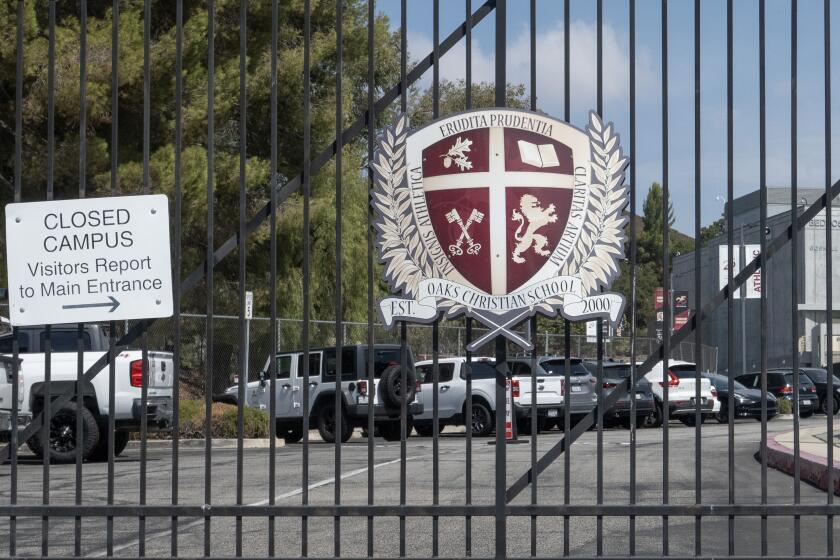Tax, Fee Hikes Will Affect Wide Range of Individuals
Married renters will see their state tax credit shrink by $17.
A family visiting a state beach may have to pay more than double the present daily rate for a picnic site.
And a Californian attending Cal State will pay $72 more to enroll in a year of classes.
These are some of the ways Californians will help pay for state government this fiscal year through higher taxes and fees. Others who bear a bigger burden of financing the new state budget enacted by Gov. George Deukmejian and the Legislature are large businesses, owners of unclaimed bank accounts and newly arrived owners of motor vehicles.
These newly devised demands on specially targeted consumers will be in addition to the nickel-a-gallon hike in the gasoline tax that takes effect today, the first installment of the voter-approved increase.
The state Department of Transportation estimates that the 5-cent levy will cost the average California driver an additional $11 between now and Jan. 1, when it jumps again by another penny a gallon and thereafter rises another cent a year until it reaches 9 cents a gallon in 1994. By then, the new taxes will have added $60 a year to the average driver’s fuel costs, a department official estimated.
But, for many a commuter in Southern California, the tax bite will be much higher. For example, a driver with an 80-mile two-way trip could easily pay $120 by 1994 for the increased costs in just his daily commute.
The gas tax increase, approved by voters in June, will finance an $18.5-billion program to upgrade transportation in California in the next decade.
To balance the state budget for the fiscal year that began July 1, Deukmejian and the Legislature agreed on a patchwork quilt of cuts in state services and increases in taxes and fees. The biggest consumer taxes--on sales and income--were left untouched.
But for married renters, who have become accustomed to receiving a state income tax credit of $137 for the past decade, the sum will be cut to $120 on their 1990 income tax return. This will cost approximately 2.6 million renters $52 million.
The credit for a single renter remains at $60 a year.
In the vast system of state parks and beaches, officials are looking at mammoth increases in fees to produce $16 million.
Although no decisions have been made, the Department of Parks and Recreation estimated that fees would have to be increased 140% from January through June, a spokesman said.
Thus, a family visiting popular South Carlsbad State Beach in San Diego County would pay $29 a night for a campsite, compared with $12 a night currently. The same family would pay more than double for a day-use permit--$9.50 instead of $4.
Department spokesman Larry Paynter said it appears unlikely that users would tolerate such high fees and might quit visiting beaches and parks. A possible alternative, he said, would call for lesser fee hikes combined with layoffs in the 2,000-employee department.
At the University of California and the California State University systems, fee increases for both residents and non-residents are in store for the coming fall term. The final decision will be made by the UC regents and the Cal State trustees.
At the nine-campus UC system, the annual fee for California residents averages $1,476, excluding room, board, educational materials and transportation. Under the budget plan, it would jump 10% to $1,624.
Additionally, the fee paid by out-of-state students, which now averages $5,799, would soar to $6,417.
At the 20 Cal State campuses, Californians annually pay an average of $708 each, which will increase to $780. Out-of-state students have been paying $5,670, which will go up to an average of $6,160.
For Californians learning a job skill as an apprentice carpenter, plumber or in another trade, the state budget authorizes the Department of Industrial relations to levy first-time fees to either the learner, his or her employer or a combination of both.
Currently, there are 51,000 participants in state-regulated apprenticeship programs. The department must determine the level of charges and who must pay the nearly $5 million.
Other budget-balancing devices:
The contents of bank accounts that have had no activity for three years will be turned over to the state if the depositor cannot be located. This would produce up to $279 million over three years. Currently, such unclaimed property is transferred to the state after five years.
A new smog “impact” fee of $300 will be charged to out-of-state motorists who register about 350,000 cars and light trucks that do not meet California’s strict exhaust emission standards. The charge will be in addition to existing registration fees and produce about $75 million.
A complex series of changes in the way big businesses are taxed by conforming state codes to federal law, raising about $561 million in the new fiscal year. Basically, the modifications involve complex accounting changes that accelerate payments to the state and restrict application of California statutes that can be used in the financing of leveraged buyouts.
“I wouldn’t say we were overly enthusiastic about it,” California Chamber of Commerce President Kirk West said of the business-tax boost. “We acceded to it.”
The same $561 million in business taxes had been expected to help finance the campaign for Atty. Gen. John K. Van de Kamp’s anti-gang and illegal drug initiative on the November ballot. But the governor and Legislature took the sum instead for budget-balancing purposes.
“I think most of our people would rather make a contribution to the state budget crisis rather than to the initiative,” West said.
More to Read
Sign up for Essential California
The most important California stories and recommendations in your inbox every morning.
You may occasionally receive promotional content from the Los Angeles Times.










